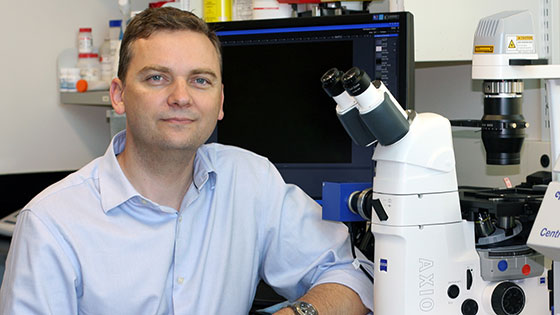Science and Medicine in Treatment and Cure
"The patients being treated today who have access to these new drugs are going to do a lot better than patients treated in the past."
"And beyond that, we have a number of exciting new drugs under clinical development at present that show even more promising results."
"What we're trying to understand is why all of these treatments haven't been curing myeloma."
"It seems likely that some of these [new classes of drugs and immunologic therapies] will be highly effective, and may eventually augment or replace current therapies, to further improve the outcome of multiple myeloma patients."
Dr. Rodger Tiedemann, hematologist, Princess Margaret Hospital, Toronto, and Ontario Cancer Institute
 |
| Dr. Rodger Tiedemann and team have discovered the root cause of multiple myeloma relapse. (Photo: UHN) |
Medical science has made great strides in the past fifty years. Incrementally, research into advanced body imaging techniques, therapeutic treatments, surgical techniques and innovations in pharmacology have led to improved treatments of conditions that were once thought to be death sentences on diagnosis. Even long-term chronic illnesses' conditions have been hugely advanced through the discoveries that make it possible to give more quality to peoples' lives while they live with their illnesses.
Long-acting injectable therapies for schizophrenia now result in far better control of the condition, requiring fewer emergency room trips and far fewer days spent in hospital -- in comparison with the regimen of daily oral medicines -- resulting in stress reduction on patients, and placing far less strain on hospital resources and healthcare budgets. Today, as a result of novel medicines, a 20-year-old who has been diagnosed with HIV now has a life expectancy into their 70s.
Hepatitis C has been cured. Two of three people diagnosed at present with cancer are able to survive past that critical five-year period, in comparison to the one-in-three that did so in the 1960s. A corresponding decline in mortality as a result of cancers being treated with elevated success rates due to medical innovation has marched in lock-step with favourable outcomes leading to greater longevity.
Over his twenty-year career as a hematologist, Dr. Tiedemann has seen new chemotherapy drugs introduced, along with the development and use of proteasome inhibitors, advancing the quality and effectiveness of care for myeloma patients. Irrespective of the drug used, however, he also saw the return of the original cancerous state. Persuading him to shift his research focus in an effort to analyze what was occurring, how it could be solved.
"If you think of multiple myeloma as a weed, then proteasome inhibitors such as Velcade are like a persnickety goat that eats the mature foliage above ground, producing a remission, but doesn't eat the roots, so that one day the weed returns."
There is no cure for myeloma, a cancer of certain blood cells, with its original prognosis of three years or less to live, beyond diagnosis. Treatment consisted of a cocktail of three chemotherapy drugs, leaving sufferers in a state of extreme lassitude. Two of the drugs have been retired over the years as newer, more useful drugs have taken their place, sufficiently effective to see improved response rates.
The outlook for myeloma patients is on a rising curve, though a cure remains elusive. An estimated, 1,450 Canadians continue to die of the disease every year. But thanks to new innovations in medicine, life expectancy has doubled. In 2013, the presence of rare immature tumour cells was discovered in most patients with myeloma. These primitive tumour cells, Dr. Tiedemann suspects, may respond differently to treatment, and may be implicated in relapses in patients.
Dr. Tiedemann looks to some of the most impressive treatments for the near future, such as chimeric antigen receptor T-cell (CAR-T) therapy, involving the collection of cells in our immune responses, T-cells gathered from patients that are genetically engineered to recognize tumour cells, then infused back into the patient. The modified cells attack and destroy the tumour cells, recognizing them for the foreign invaders they are, leaving behind the healthy cells.
The goal of improving and extending the lives of people diagnosed with myeloma, thanks to new medicines, new classes of drugs and new immunologic therapies is on the cusp of making all the difference in outcomes. Anticipating imminent approval for innovative new treatments, Dr. Tiedemann visualizes another leap forward in life expectancy, though that won't stop his search for a cure.
 |
| Princess Margaret Hospital, Toronto |

0 Comments:
Post a Comment
<< Home